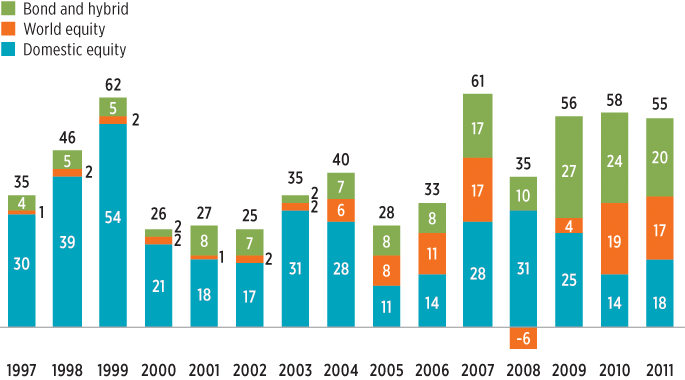ICI Understanding the Risks of Bond Mutual Funds Are They Right for Me
Post on: 16 Март, 2015 No Comment

I. Are Bond Mutual Funds Right for Me? 
Is bond mutual fund investing right for me?
Bond mutual funds—like all mutual funds—involve investment risk, including the possible loss of principal. A fundamental principle of investing known as the risk/reward tradeoff means that when you make an informed decision to assume some risk, you also create the opportunity for reward. Investors should be aware of the risks and potential for losses associated with bond mutual fund investing.
How do the risks and returns of bond mutual funds compare with those of other investments?
Investing in bond mutual funds usually entails less risk—and less reward—than investing in stock mutual funds. Similarly, bank accounts and money market funds entail less risk and less reward than do bond mutual funds. Bank deposit accounts, such as savings accounts or certificates of deposit, are insured against loss up to certain levels by the Federal Deposit Insurance Corporation (FDIC). Money market funds invest in very short-term, high-quality securities and attempt to maintain a constant share price (value). However, an investment in a money market fund is not insured or guaranteed by the FDIC or any other government agency, and it is possible to lose money in a money market fund.
Can a bond mutual fund be guaranteed?
There are no guarantees when investing in a bond mutual fund. Even if the individual bonds in the fund are guaranteed by the government or insured through a private insurer, the value of a bond mutual fund investment can still rise or fall. Bond mutual funds are not insured or guaranteed by FDIC, the U.S. Securities Investor Protection Corporation (SIPC), or by any other government agency, regardless of how a bond mutual fund is purchased or sold—whether through a brokerage firm, bank, insurance agency, financial planning firm, or directly. Nor are they guaranteed by the bank, brokerage firm, or other financial institution where they are sold.
What risks do investors in bond mutual funds face?
Bond mutual fund investing involves four types of risk: interest rate risk, credit risk, prepayment risk, and inflation risk.
How does interest rate risk affect a bond’s value? 
Interest rate risk is the possibility that a bond’s price will change due to a change in prevailing interest rates. Bond prices are closely related to interest rates. When interest rates go up, most bond prices go down. When interest rates go down, bond prices go up.
Interest rate risk is commonly measured by a bond’s duration. Duration is a measure of the sensitivity of a bond’s price to interest rate movements. A bond’s duration depends heavily on the remaining maturity of the bond and is often expressed in years.
In general, the longer a bond’s remaining maturity, the higher its duration will be and the more its price will tend to fluctuate as interest rates change. For example, a bond with 20 years left to maturity will have a higher duration than an otherwise equivalent bond with 10 years left to maturity. Consequently, a rise in interest rates will cause a larger drop in price for the bond with the higher duration. However, while longer-term bonds tend to fluctuate in value more than shorter-term bonds, they also tend to have higher yields as a result of this risk.
Can you provide an example of the impact of interest rate changes on a bond’s value?
Let’s say an investor today buys a newly issued bond that pays a fixed 5 percent in interest each year for a total of 30 years. The maturity of this bond is 30 years. The duration of this bond, however, is about 16 years. The duration of the bond is less than the maturity because the investor will receive cash in the form of interest payments during the life of the bond.
If interest rates were to change tomorrow, the duration tells us how much the investor should expect the price of the bond to change in the opposite direction. For example, an increase of 1 percentage point in prevailing interest rates would lower the price of this bond by 16 percent. The bond is worth less because other investors are now able to purchase bonds that are paying 6 percent in interest each year. The bond that is paying 5 percent is less attractive to investors and as such must have a lower price to induce investors to buy it. The opposite is true when interest rates decline. In our example, if interest rates were to decrease by 1 percentage point, the price of the investor’s bond would be expected to rise by 16 percent.
The bond would pay more in interest payments (5 percent) than what the current market offers (4 percent), and the bond’s owner would receive a higher price for the bond if he or she were to sell it.
What is credit risk?
Credit risk refers to the creditworthiness of the bond issuer and its expected ability to make timely interest payments and to pay the face value of the bond at maturity. If a bond issuer is unable to repay principal or interest on time, the bond is said to be in default. A decline in an issuer’s credit rating, or creditworthiness, will cause the prices of its bonds to decline and may cause the share prices of a fund that holds the issuer’s bonds to decline as well.
An issuer’s   creditworthiness is usually expressed in terms of bond credit ratings issued by one or more credit rating agencies. The following chart shows bond ratings used by Moody’s Investors Service, Inc. or Standard Poor’s Corporation (SP) from highest credit quality to lowest credit quality.














